In an Asian home, longevity noodles are always lovingly prepared to honor one’s birthday. According to its Chinese name, chang shou mian (or literally, long-life noodles), it represents a long life of happiness.
You might like to prepare it for your loved ones or eat it frequently. In any case, we’ve put our recipes through a rigorous taste test, so we can offer you two different ways to prepare this meal.
Continue reading to learn more about the dish and its recipes so you can make your own version of it, whether you favor a bowl of hot soup or the grease of stir-fried dishes.
Longevity noodles are made of long, thin Asian wheat flour noodles (referred to as mian in Chinese), which are cooked in a vegetable-infused broth with sesame oil and soy sauce. The Hokkien method of preparing them is to stir-fry them with Chinese egg noodles. Hokkien is a Chinese dialect group from Southeast China.
Some people like to make homemade longevity noodles from scratch. Pulling dough made of wheat flour into long, elastic strips and cooking them will produce these kinds of mian.
Better tasting than hand-cut and machine-made noodles, handmade mian requires more work. Freshly cooked noodles have a springy, chewy texture that makes the effort worthwhile.
Longevity Noodles have a symbolic meaning. Chinese “long face noodles,” or “chang shou mian,” are said to bring happiness and long life when you eat them, according to tradition.
As a result, they are frequently consumed by the Chinese during Chinese New Year and other auspicious occasions like birthdays.
The custom comes from Han Chinese culture, which holds that those with long faces typically live longer. Therefore, they started eating these long-life noodles. You must consume the entirety of a bowl of mian in one sitting if you have one.
Because it’s the beginning of a new year and we want to wish everyone a prosperous new year, longevity noodles are consumed during Chinese New Year. The length of the mian, which is unbroken, indicates that everything will go smoothly and without any difficulties for the person who is eating it. The cook never serves the strands severed or cut, and the diner should attempt to consume each strand in a single gulp.
Cooks typically add garlic, shallots, diced tomato, mushrooms, and baby bok choy to the dish. They usually cook all of these with soothing chicken broth. The dish is also sometimes stir-fried by some chefs, usually with a small amount of sesame or peanut oil added for flavor.
You can always alter the ingredients slightly to suit your preferences, much like the shrimp chow mein recipe.
Buy a packet of mian without eggs if you want to make vegan longevity noodles or a vegetarian version. The majority of the time, the ingredients used to make the packages sold in supermarkets are wheat, water, salt, and oil. If you double-check the packaging ingredient to make sure eggs aren’t present, you can use them for a vegan adaptation.
For instance, this Amazon-sold packet of chang shou mein is egg-free. Even a set of chopsticks is included so you can practice mian handling!
In accordance with Chinese custom, birthday cake is optional but longevity noodles are a requirement. Mee sua is the Hokkien name for these vermicelli-like strands of flour. Asian parents typically serve them to the birthday recipient in this manner: smooth, long, and uncut. There’s a reason for this: Long main strands denote a long life.
Typically, vermicelli is served in a bowl of hot, flavorful chicken broth. The soothing longevity noodle soup embodies the chefs’ heartfelt wishes. Red is considered to be an auspicious color in Chinese culture, and eggs symbolize a fresh start.
Finally, since the vermicelli is typically made without eggs, longevity noodles can be categorized as vegetarian. For the majority of vegetarians, we would cook this vermicelli bowl in a broth made from boiled lotus root, mushrooms, carrots, and leafy greens instead of using chicken.
500 calories worth of stir-fried longevity noodles contain 153 calories from fat. Depending on the toppings used, the calorie count for a dish cooked in soup typically ranges from 150 to 300 kcal.
Longevity noodles are available pre-made at any Asian grocery store or on Amazon. They typically come in a red box with preparation instructions. If you prefer to prepare a soup-based version, watch out for the tiny vermicelli strands. However, if you want to stir-fry the dish, look for yellow egg noodles.
Although you can make your own handmade longevity noodles, most people opt to purchase pre-made mian for convenience in the kitchen.
Long Life Noodles: Recipe Instructions
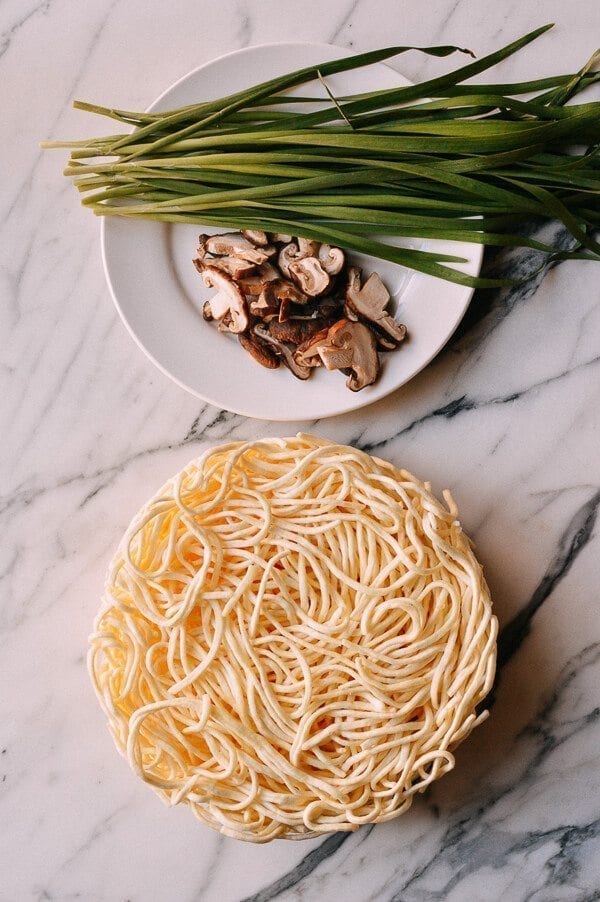
To prepare the Yi Mein noodles, bring 3 quarts of water to a boil in a sizable wok or pot. Once boiling, add the noodles.
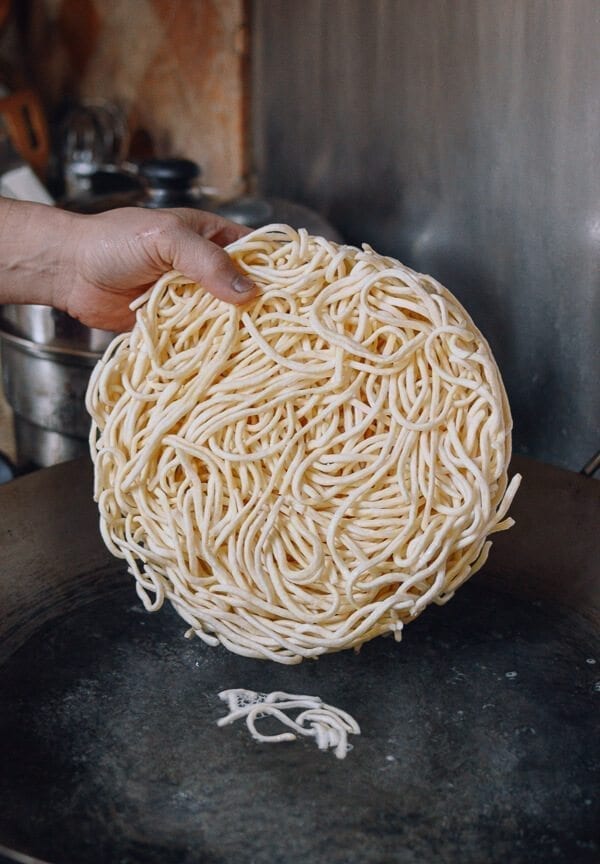
Although the package may instruct you to boil the noodles for five minutes, we suggest boiling them for no longer than three to four minutes to keep them firm and chewy. If you overcook them, the texture will become mushy.
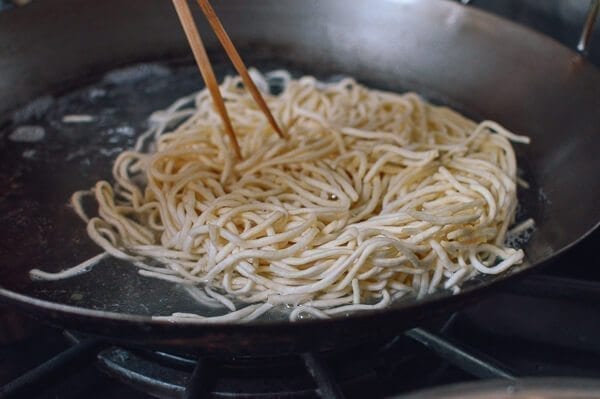
When a noodle tastes more like the uncooked end of al dente pasta, it is finished cooking. When the noodles are done, immediately drain and set aside.
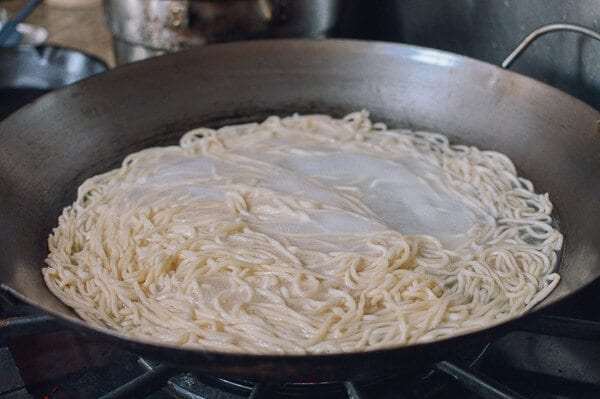
Spread 2 tablespoons of oil around the wok’s perimeter after heating it to just smoking temperature.
Stir-fry the shiitake mushrooms and the Chinese chives’ light green parts for 30 seconds. If the mushrooms appear to be too dry, add another tablespoon of oil because they absorb the oil like sponges.
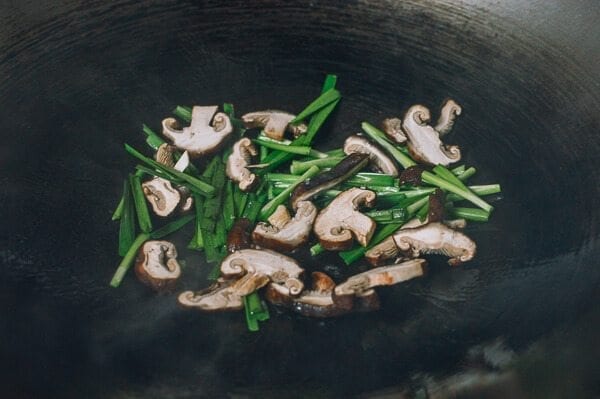
Add the noodles, stirring everything for an additional 20 seconds until they are warm but not wet. Warming the noodles before adding the sauce is crucial, so if they cooled off, simply cook them a little bit longer until they are warmed.
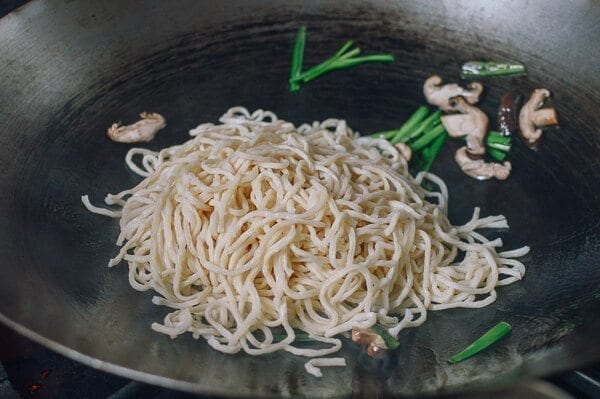
Over the noodles, evenly distribute the prepared sauce mixture, and stir-fry everything for one minute, or until the soy sauce mixture is distributed. If you think it’ll help, add one more tablespoon of oil to the wok’s outer rim to prevent sticking.
How much oil you use is definitely a personal preference. Put a little oil on the noodles if they start to stick together. If the noodles are still too dry after adding the sauce, you can also add a small amount of hot water.
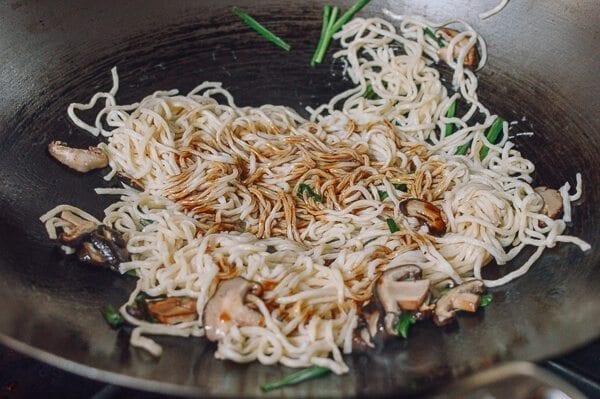
Mix gently so you don’t break up the noodles. Keep in mind that long noodles will bring longevity and prosperity to the diners of this meal!
When the noodles are thoroughly heated, add the remaining chives green parts and stir until they turn bright green.
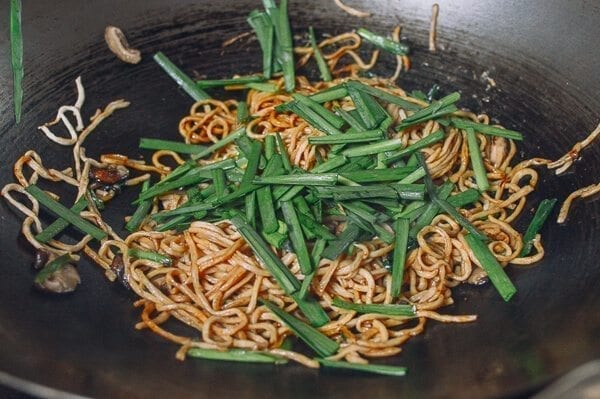
Depending on whether your noodles were cold when you started stir-frying them or still warm, and how hot your stove and wok can get, this will take 1-3 minutes.
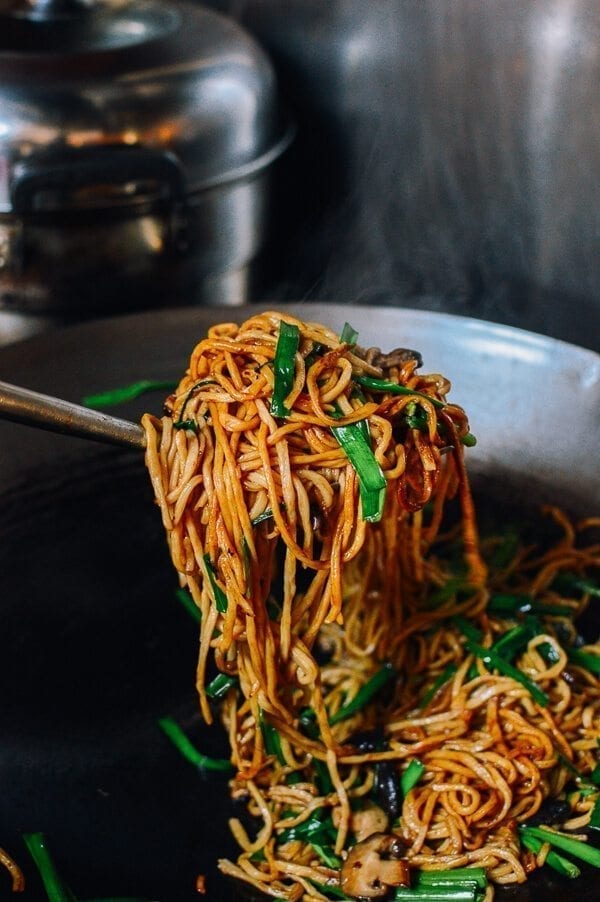
Plate and serve your long life noodles!
With some of Kaitlin’s Homemade Chili Oil, we advise you to eat these noodles!
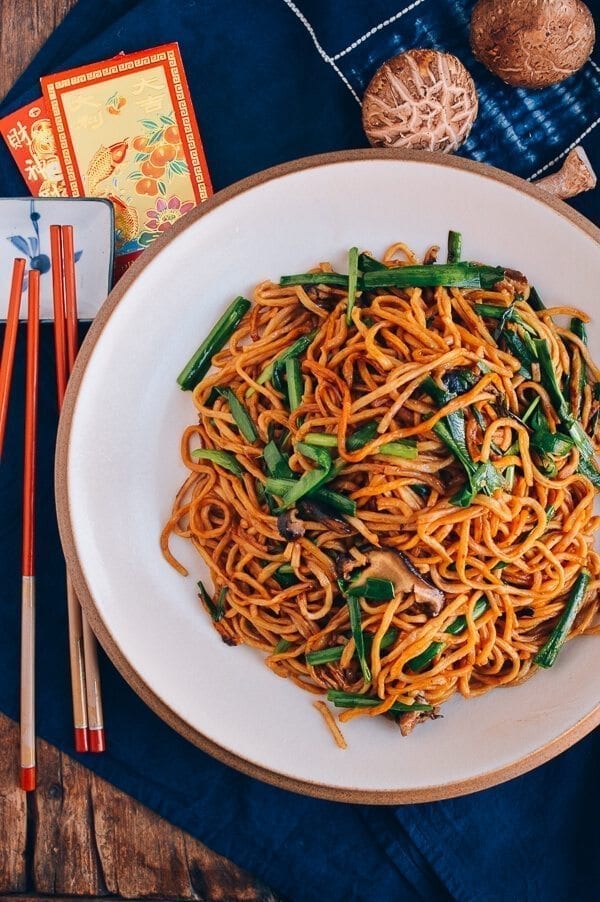
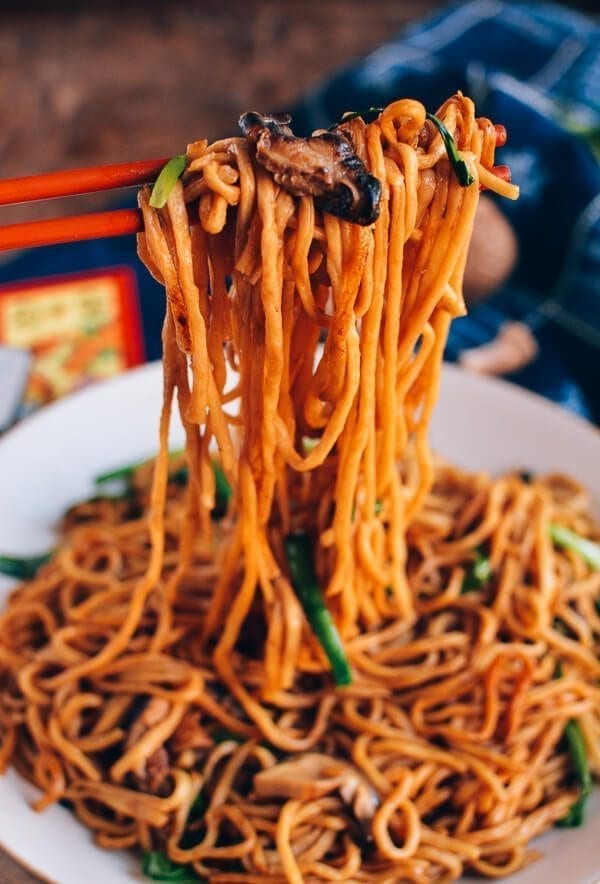
Looking for more authentic recipes? Subscribe to our email list and be sure to follow us on Pinterest, Facebook, Instagram, and Youtube!
Nutrition Facts Per Serving: 164 calories; fat 5g; saturated fat 0.5g; mono fat 2.4g; poly fat 2g; protein 9.3g; carbohydrates 19.6g; fiber 0.8g; cholesterol 14mg; iron 0.6mg; sodium 550mg; calcium 36mg. Advertisement
Ive made these noodles a few times now. I keep the proportions as is for a side dish. I double the pork for the main course (chicken would work too) and add sliced shiitake mushrooms or other vegetables. The dark soy sauce is key. It was in my neighborhood Asian market, and it gives the dish a restaurant-quality flavor. My only minor criticism is that it could use a little more of a punch. Typically, siracha or a dusting of red pepper flakes works. Good food.
We used soba wheat noodles, substituted chicken for the pork, and increased the amount of mushrooms in the recipe. Because I was out of dark soy, I only used regular soy. We doubled both sauces, but if you’re planning to have leftovers, you could probably triple them. Will definitely make again.
These were great! Definitely double the sauce. I also used dried wide noodles.
very tasty recipe, a little on the sweet side. easiest chinese noodle recipe i have made.
Because I had a bad experience with fresh Asian-style noodles the last time I tried to make a lo mein-style dish, I started out with dry noodles rather than fresh ones. Just cooked some spaghetti and used that. Additionally, since I was preparing this as a side dish, I omitted the pork. I thought it didnt have enough veggies in it. The next time, I’ll double the cabbage and increase the sauce slightly because the first night’s portion had plenty, but the leftovers lacked sufficient sauce. Despite all my changes, I really enjoyed this recipe!.
I was unable to locate dark soy sauce and didn’t have oyster sauce. You cannot replace those ingredients apparently. Fish sauce, low sodium soy sauce, and some sirracha were all I had on hand. Really nothing in the recipe that makes it special. Pretty basic. Add some peppers or mushrooms to give it some balance. Meat, cabbage and noodles just dont seem to be enough.
I agree with the other poster who doubled the sauce. I felt that this was a little bit dry, so if I were to make it again, I would definitely double the sauce. Because I had chicken in the house instead of pork, I substituted that. I awarded this two stars because I concur that it “has potential.”
Very good dish for simple easy meal. I increased the sauce by two times and the amount of pork by two times. I increased the recommended amount of cabbage and decreased the amount of noodles to 12 oz, which was still a lot. I might attempt to make this dish with even fewer noodles and a steamed vegetable.
All three of my little picky eaters enjoyed this meal, despite the fact that it wasn’t a special occasion meal (I detest that phrase on this ranking). Very light flavors yet filling. It is very noodle-heavy, which I like, but for better balance, the next time I make it, I’ll double the pork and its sauce.
I decided to stick to the recipe and use the ingredients in the amounts specified, but I only used a 9oz package of Chinese wheat noodles. I believed that fewer noodles, in the proper proportion with the pork, cabbage, and scallions, were actually preferable to more noodles. DH didn’t typically enjoy noodle dishes, but he really enjoyed this one. I substituted Kikkoman soy for both dark and light soy because I was out of both. I noticed that the sauce had a slight saltiness to it, but that is undoubtedly due to the soy sauce I used. Next time I would use more cabbage, maybe 4 cups. Good everyday meal but might serve for guests. Served with asparagus. Advertisement.
Popular Foods Eaten During Chinese New Year
The Spring Festival is an exuberant celebration that places a focus on family values and sends good wishes for wealth and fortune in the coming year. Fireworks, firecrackers, and decorations in bright red are used in celebrations throughout the world. However, no Chinese New Year celebration would be complete without a variety of mouthwatering and customary foods!
Even though these foods are delicious (and colorful), it’s typical to serve noodles as a celebratory dish. In many Asian cuisines, noodles are a main ingredient in soups and stir-fries. For this reason, longevity noodles are also appropriate for a delectable Chinese New Year’s feast!
FAQ
What is another name for longevity noodles?
Yi mein noodles, also known as e-fu noodles or longevity noodles, are combined with green onions, garlic, and mushrooms to make a dish that is incredibly filling. Soy sauce, oyster, sesame oil, and white pepper are used to season the noodles. Onolicious as a side dish, or a simple main dish!.
Are longevity noodles healthy?
This recipe for Chinese longevity noodles is flavorful and filled with chicken and nutritious greens. It’s a healthy and hearty comfort food meal.
What do longevity noodles represent?
Foods prepared and consumed during the New Year’s celebration frequently have symbolic meanings intended to evoke wealth and fortune. The term “longevity noodles” here is self-explanatory: the length of the noodles represents a long and fulfilling life.
What is Chinese longevity noodles?
Long Life Noodles (y miàn, ) or yi mein are a staple of Chinese banquet tables because they represent longevity. E-fu noodles, also referred to as yi mein, are always served at banquets for birthdays, new babies, weddings, or the lunar new year.